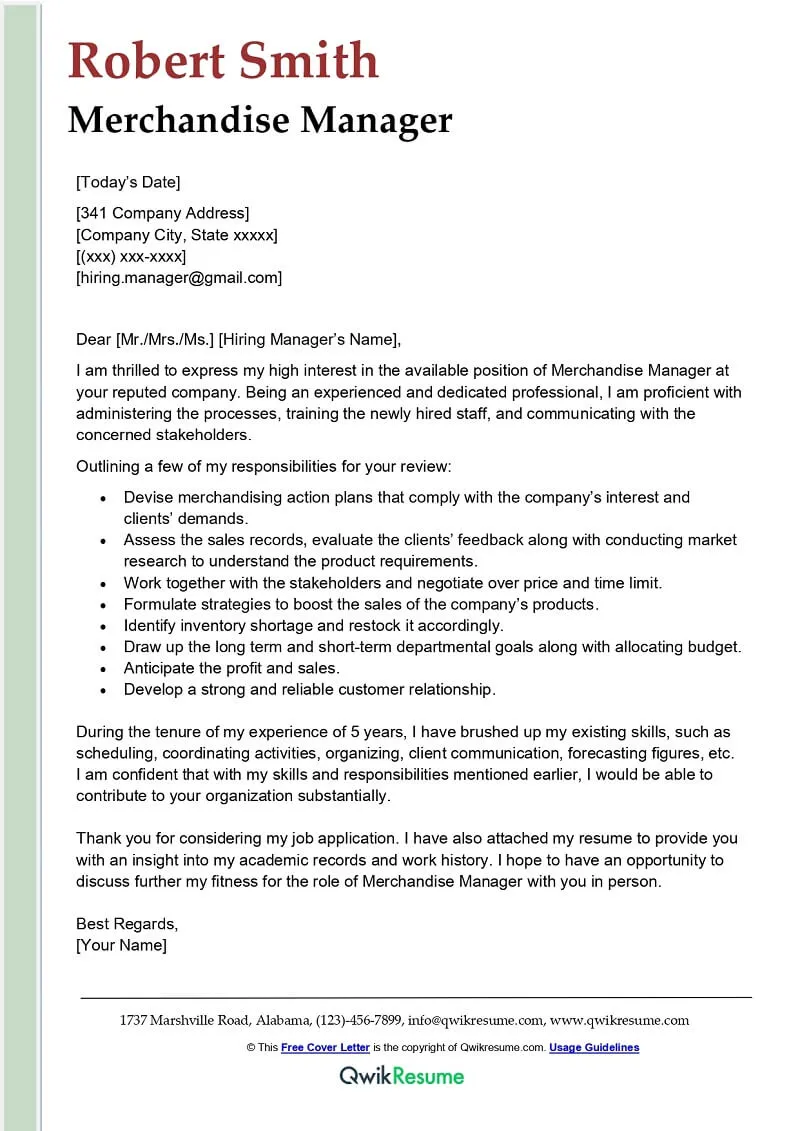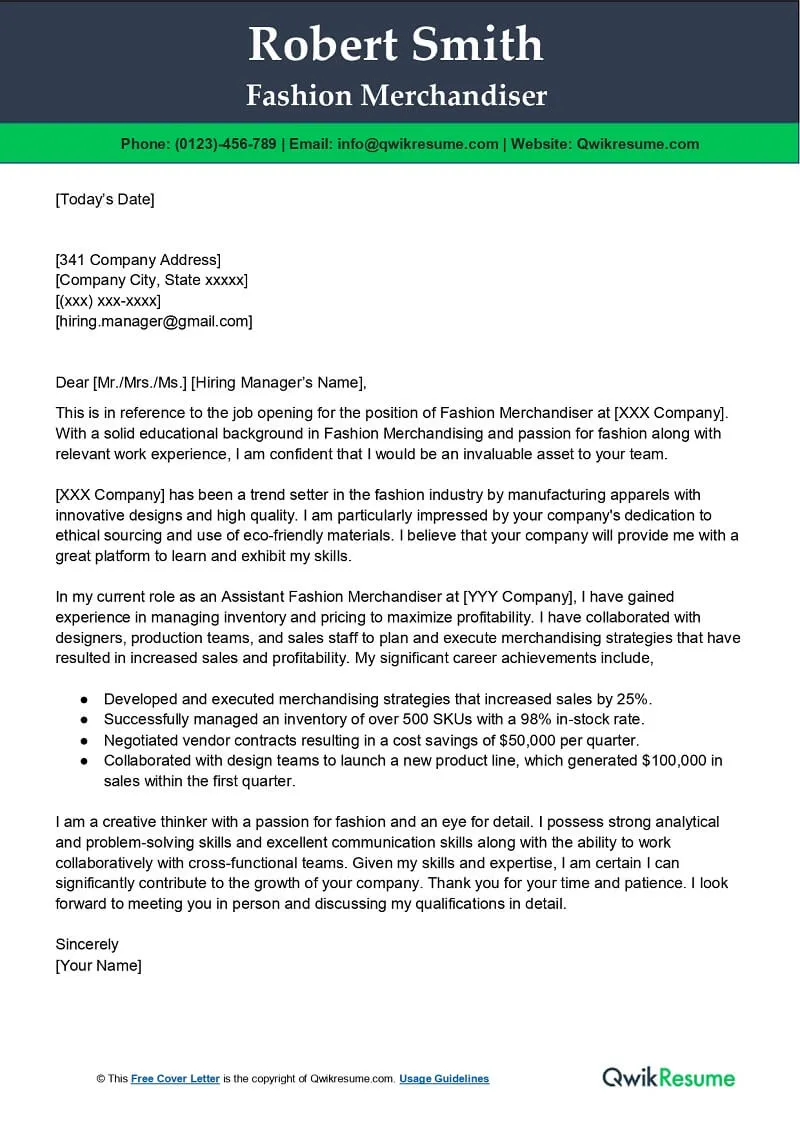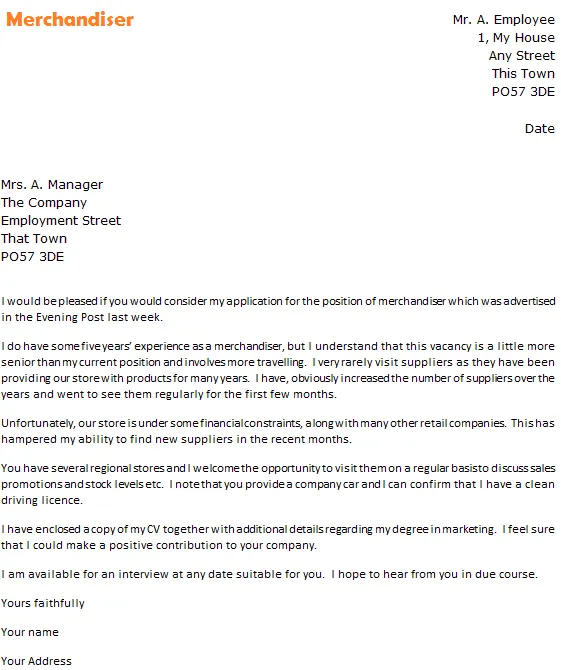A cover letter is your first impression on a potential employer, especially in the competitive world of fashion merchandising. It’s your opportunity to showcase your skills, experience, and passion for the industry. Unlike a resume, which provides a factual overview of your background, a cover letter allows you to tell your story and demonstrate why you’re the perfect fit for the job. A well-crafted cover letter can significantly increase your chances of securing an interview and landing your dream job. It’s a crucial step in the job application process and should be treated with the utmost care and attention to detail. The cover letter gives you the chance to explain the resume and what makes you unique and the right fit for this particular role and company. It also gives the hiring manager a clearer picture of your experience and the value you would bring to the table.
Cover Letter Fashion Merchandiser: The Importance
The fashion industry is all about first impressions, and your cover letter is your chance to make a stellar one. It’s more than just a formality; it’s a crucial tool to capture the hiring manager’s attention. A compelling cover letter goes beyond simply listing your qualifications; it demonstrates your understanding of the role, the company, and the industry. It allows you to articulate your enthusiasm and highlight how your skills align with the specific requirements of the job. Furthermore, a well-written cover letter differentiates you from other candidates and makes your application memorable. A strong cover letter will showcase your passion for fashion and merchandising. It tells a story, provides context, and allows you to connect with the hiring manager on a more personal level, setting you apart from other applicants and ultimately increasing your chances of landing an interview.
Highlighting Your Fashion Merchandising Skills
Fashion merchandising requires a diverse skillset, so it’s essential to highlight the skills that are most relevant to the job you’re applying for. Identify the key requirements outlined in the job description, and then showcase your abilities in those areas. These can include skills such as market analysis, trend forecasting, inventory management, visual merchandising, and excellent communication. Provide specific examples to demonstrate how you’ve successfully utilized these skills in previous roles. For example, you might describe a time when you improved sales by implementing a new visual merchandising strategy or managed to reduce inventory costs through efficient planning. Tailor the skills you highlight to each job, emphasizing those that align with the specific needs of the employer. This shows that you have the expertise and the capability to excel in the role, and can articulate how you’ve successfully used these skills in the past.
Showcasing Relevant Experience in Cover Letter

Your cover letter is the perfect place to elaborate on your experience and provide context that your resume alone cannot. Focus on experiences that are most relevant to the job you’re seeking. Instead of simply listing your responsibilities, provide specific examples of your accomplishments and the impact you made in previous roles. Quantify your achievements whenever possible. Instead of saying you “increased sales,” mention the percentage increase. Detail the projects you managed, the challenges you overcame, and the skills you utilized. By showcasing your past successes, you provide concrete evidence of your ability to perform well in the position you’re applying for. Highlight the experience that aligns with the job description and the needs of the employer, and be sure to showcase specific accomplishments.
Tailoring Your Cover Letter for Each Job
One of the biggest mistakes job seekers make is sending out generic cover letters. Each cover letter should be customized to the specific job and company you’re applying for. Research the company’s values, mission, and culture. Identify the specific skills and experiences they’re seeking and then tailor your cover letter to address those requirements directly. Mention the company by name and demonstrate that you understand their brand and their target market. Show that you’ve taken the time to learn about the company and are genuinely interested in the opportunity. Avoid using a template that can be identified as generic. This personalized approach demonstrates your genuine interest in the position, and it increases the likelihood that your application will stand out from the crowd, increasing the chances of being noticed and selected for an interview.
Quantifying Achievements in Your Cover Letter
Numbers speak louder than words, especially in the competitive world of fashion merchandising. Whenever possible, quantify your achievements to demonstrate the impact you’ve made in previous roles. Instead of saying you “improved sales,” mention the specific percentage increase. Instead of saying you “managed inventory efficiently,” state how you reduced inventory costs or decreased stockouts. Providing concrete data adds credibility to your claims and provides the hiring manager with a clear understanding of your value. Use metrics like sales growth, profit margins, customer satisfaction scores, and inventory turnover rates to showcase your successes. This approach makes your achievements more tangible and provides the hiring manager with concrete evidence of your ability to perform in the role.
Cover Letter Formatting and Presentation

The presentation of your cover letter is as important as its content. Use a professional font, such as Arial or Times New Roman, and maintain a clean and readable format. Keep the letter concise and easy to skim, with clear headings and bullet points where appropriate. Use a standard business letter format, including your contact information, the date, and the hiring manager’s name and title. Proofread your cover letter carefully for any typos or grammatical errors. A polished and well-formatted cover letter demonstrates your attention to detail and professionalism. Ensure your cover letter is free of errors. A well-presented cover letter reflects your professionalism and enhances your chances of making a positive impression. Proper formatting enhances readability and makes it easier for the hiring manager to quickly grasp your key qualifications and accomplishments.
Cover Letter Fashion Merchandiser: Proofreading & Editing
Before submitting your cover letter, it’s essential to proofread and edit it carefully. Typos and grammatical errors can undermine your credibility and give the impression that you lack attention to detail. Read the letter aloud to catch any awkward phrasing or unclear sentences. Ask a friend, family member, or career counselor to review your cover letter for feedback. Ensure that your cover letter is free of errors and effectively communicates your qualifications and enthusiasm. A polished cover letter is a reflection of your professionalism and attention to detail. The final step is to ensure your cover letter is free of any errors, as this will show your attention to detail and professionalism. A well-proofread cover letter significantly increases your chances of making a positive impression on the hiring manager, increasing your odds of landing that interview.
In conclusion, a well-crafted cover letter is essential for any aspiring fashion merchandiser. By highlighting your skills, showcasing relevant experience, tailoring your letter to each job, quantifying your achievements, and paying attention to formatting and presentation, you can significantly increase your chances of landing an interview. Remember to proofread carefully and tailor your letter to each specific job application. By following these tips, you can create a compelling cover letter that will make a lasting impression and help you stand out in a competitive job market, paving the way for a successful career in fashion merchandising.
